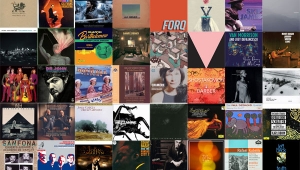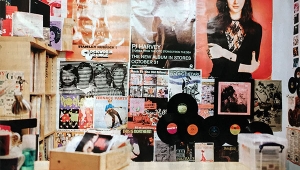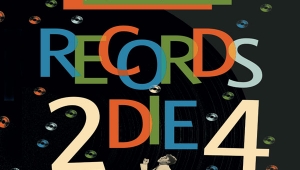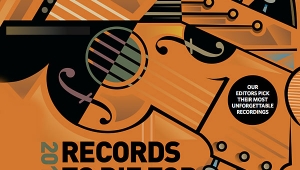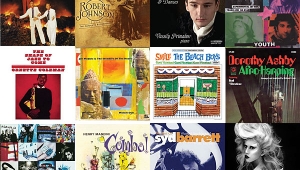| Columns Retired Columns & Blogs |
2000 Records to Die For Page 4
Daniel Buckley
DON CHERRY: Brown Rice
Don Cherry, trumpet, electric piano, vocals; Frank Lowe, tenor sax; Ricky Cherry, electric piano; Charlie Haden, Hakim Jamil, acoustic bass; Moki, tamboura; Billy Higgins, drums; Bunchie Fox, electric bongos; Verna Gillis, vocals
A&M/Horizon 0809 (CD). 1976/1988. Corrado Bacchelli, Beppe Muccioli, prods.; Kurt Munkacsi, Michael Mantler, engs. AAD? TT: 39:17
In the wake of the global jazz-fusion experiments Miles Davis released on Big Fun, former Ornette Coleman trumpeter Don Cherry, fresh from world-music encounters at Woodstock's Creative Music Studio, turned out this seminal masterpiece under the keen ears of Philip Glass engineer Kurt Munkacsi and Carla Bley's trumpeter husband, Michael Mantler. Predating and pointing toward Cherry's later collaborations, under the name Codona, with percussionist Nan;aa Vasconcelos and multi-instrumentalist Colin Walcott, the four strong jams on Brown Rice pull every corner of the planet together with pulsing energy. The title track is a masterpiece. Over a funky wah-wah bass line, sizzling electric bongos, unearthly modal female vocals, and driving ostinato electric piano, Cherry whispers nursery-rhyme-like lyrics while Frank Lowe sends it all to the stratosphere with scorching tenor-sax screams. Primal, groovy, and mysterious, it is among the best of an exciting era in jazz, and there's plenty more where that came from.
KING CRIMSON: Larks' Tongues in Aspic
Robert Fripp, guitar, Mellotron, devices; David Cross, violin, viola, Mellotron; John Wetton, bass, vocals; Bill Bruford, drums; Jamie Muir, percussion
Editions EG 1506 (CD). 1973/1989. King Crimson, prods. Nick Ryan, eng. AAD? TT: 46:41
In the early '70s, a variety of bands—from Yes to Genesis, Gryphon, and Gentle Giant—flew the "classical rock" banner, creating extended electric soundscapes that were a far cry from rock's R&B roots. But it wasn't until this crop of King Crimson members—and this album in particular—that works of that genre finally achieved a level of sophistication to be placed alongside the best in the contemporary classical literature. The title track is a monster instrumental, building from soft, tinkling kalimbas and metallic percussion through brooding guitar and string interludes to sudden and crushing tidal waves of sound and fury. The virtuosity, textural richness, and broad-scope architecture of most of the six extended works on this disc make it among the '70s' best in any genre. Lyrically, the three songs are as strong as the instrumental tracks. For ferocity, sheer genius and fine recording quality, this is a landmark recording.
PRIMAL SCREAM: Screamadelica
Creation/Sire 26714-2 (CD). 1991. Andrew Weatherall, Hugo Nicholson, Jimmy Miller, prods. AAD? TT: 62:54
You won't see it on any lists in this country, but across the pond, Screamadelica is a cinch as one of the top three records of the '90s, and with good reason. How is it that the only record of the decade to successfully wed ambient, techno, and house tropes to classic rock'n'roll structure came out in 1991? Primal Scream were also way ahead of the curve when it came to samples, collages, remixes, and ripoffs—the very things that most '90s music is about. Screamadelica has it all: Muscle Shoals-inspired pop anthems and gospel-tinged disco futurism, psychedelic chill-outs and groovy-weird funk trips, a housed-up Roky Erickson cover, and a heartbreakingly perfect ballad chipped off of the Rolling Stones' "Winter." It's a party record, a drug record, and an art record, but it's also a song record—unlike so much that has come in its wake.
YOU AM I: Hourly, Daily
Ra/Sire 31006-2 (CD). 1999. You Am I, George Drakoulias, prods.; Wayne Connolly, Jim Scott, Paul McKercher, engs. AAD? TT: 52:12
You Am I began life as a '60s-influenced combo with just enough punk, psychedelic, and garage elements that it never quite settled on a unified sound. On Hourly, Daily, its third effort, the Aussie trio unzipped the fly of its pop obsessions. Bandleader Tim Rogers describes this fab little disc as a "beat record," and though it's possible he meant the Easybeats and not the Beatles, that's exactly what it is—a jaunty, horn-and-string-laden skiffle collection chock-full of hooks, tremolo, and "whoo-ooohs." From the stuttering chorus of "Opportunities" ("ba-ba-ba-ba-ba-big opportunity!") to the wistful "If We Can't Get It Together," Rogers' high voice and craftily innocent tunes are as confectionery as (the) Raspberries and precious enough to seem British. The record's overall demeanor is so genial and teenage that one thinks of the Monkees—or, closer to home, the Swingers, famous for their role in the brilliant "hey-kids-let's-put-on-a-new-wave-show!" musical, Starstuck. Of course, Hourly, Daily coincided with You Am I's departure from Warner Bros.—subsidiary Sire gave it a perfunctory release—making it one of the decade's utterly minor, utterly wonderful lost pop gems.
CHARLES LLOYD: Voice in the Night
Charles Lloyd, tenor sax; John Abercrombie, guitar; Dave Holland, bass; Billy Higgins, drums
ECM 1674 (CD). 1999. Manfred Eicher, prod.; James Farber, eng. DDD. TT: 68:23
In his 60th year, Charles Lloyd has reached a level of expressiveness that communicates deep feeling from spare lines and fragmentary gestures. (Picasso didn't get there until his 80s.) It all begins with Lloyd's sound, a direct welling-up of the spirit, dark and rapt, with a sheen of overtone on the surface like hope.
JOHN LEWIS & SACHA DISTEL: Afternoon in Paris
John Lewis, piano; Sacha Distel, guitar; Barney Wilen, tenor sax; Pierre Michelot, Percy Heath, bass; Connie Kay, Kenny Clarke, drums
Koch Jazz KOC-CD-8509 (CD). 1999. Donald Elfman, Naomi Yoshii, reissue prods. AAD? TT: 43:34
Afternoon in Paris is not exactly a masterpiece, and it's a typical low-budget Koch Jazz reissue. So why is it a "Record To Die For"?
DON CHERRY: Brown Rice
Don Cherry, trumpet, electric piano, vocals; Frank Lowe, tenor sax; Ricky Cherry, electric piano; Charlie Haden, Hakim Jamil, acoustic bass; Moki, tamboura; Billy Higgins, drums; Bunchie Fox, electric bongos; Verna Gillis, vocals
A&M/Horizon 0809 (CD). 1976/1988. Corrado Bacchelli, Beppe Muccioli, prods.; Kurt Munkacsi, Michael Mantler, engs. AAD? TT: 39:17
In the wake of the global jazz-fusion experiments Miles Davis released on Big Fun, former Ornette Coleman trumpeter Don Cherry, fresh from world-music encounters at Woodstock's Creative Music Studio, turned out this seminal masterpiece under the keen ears of Philip Glass engineer Kurt Munkacsi and Carla Bley's trumpeter husband, Michael Mantler. Predating and pointing toward Cherry's later collaborations, under the name Codona, with percussionist Nan;aa Vasconcelos and multi-instrumentalist Colin Walcott, the four strong jams on Brown Rice pull every corner of the planet together with pulsing energy. The title track is a masterpiece. Over a funky wah-wah bass line, sizzling electric bongos, unearthly modal female vocals, and driving ostinato electric piano, Cherry whispers nursery-rhyme-like lyrics while Frank Lowe sends it all to the stratosphere with scorching tenor-sax screams. Primal, groovy, and mysterious, it is among the best of an exciting era in jazz, and there's plenty more where that came from.
KING CRIMSON: Larks' Tongues in Aspic
Robert Fripp, guitar, Mellotron, devices; David Cross, violin, viola, Mellotron; John Wetton, bass, vocals; Bill Bruford, drums; Jamie Muir, percussion
Editions EG 1506 (CD). 1973/1989. King Crimson, prods. Nick Ryan, eng. AAD? TT: 46:41
In the early '70s, a variety of bands—from Yes to Genesis, Gryphon, and Gentle Giant—flew the "classical rock" banner, creating extended electric soundscapes that were a far cry from rock's R&B roots. But it wasn't until this crop of King Crimson members—and this album in particular—that works of that genre finally achieved a level of sophistication to be placed alongside the best in the contemporary classical literature. The title track is a monster instrumental, building from soft, tinkling kalimbas and metallic percussion through brooding guitar and string interludes to sudden and crushing tidal waves of sound and fury. The virtuosity, textural richness, and broad-scope architecture of most of the six extended works on this disc make it among the '70s' best in any genre. Lyrically, the three songs are as strong as the instrumental tracks. For ferocity, sheer genius and fine recording quality, this is a landmark recording.
![]()
Jason Cohen
PRIMAL SCREAM: Screamadelica
Creation/Sire 26714-2 (CD). 1991. Andrew Weatherall, Hugo Nicholson, Jimmy Miller, prods. AAD? TT: 62:54
You won't see it on any lists in this country, but across the pond, Screamadelica is a cinch as one of the top three records of the '90s, and with good reason. How is it that the only record of the decade to successfully wed ambient, techno, and house tropes to classic rock'n'roll structure came out in 1991? Primal Scream were also way ahead of the curve when it came to samples, collages, remixes, and ripoffs—the very things that most '90s music is about. Screamadelica has it all: Muscle Shoals-inspired pop anthems and gospel-tinged disco futurism, psychedelic chill-outs and groovy-weird funk trips, a housed-up Roky Erickson cover, and a heartbreakingly perfect ballad chipped off of the Rolling Stones' "Winter." It's a party record, a drug record, and an art record, but it's also a song record—unlike so much that has come in its wake.
YOU AM I: Hourly, Daily
Ra/Sire 31006-2 (CD). 1999. You Am I, George Drakoulias, prods.; Wayne Connolly, Jim Scott, Paul McKercher, engs. AAD? TT: 52:12
You Am I began life as a '60s-influenced combo with just enough punk, psychedelic, and garage elements that it never quite settled on a unified sound. On Hourly, Daily, its third effort, the Aussie trio unzipped the fly of its pop obsessions. Bandleader Tim Rogers describes this fab little disc as a "beat record," and though it's possible he meant the Easybeats and not the Beatles, that's exactly what it is—a jaunty, horn-and-string-laden skiffle collection chock-full of hooks, tremolo, and "whoo-ooohs." From the stuttering chorus of "Opportunities" ("ba-ba-ba-ba-ba-big opportunity!") to the wistful "If We Can't Get It Together," Rogers' high voice and craftily innocent tunes are as confectionery as (the) Raspberries and precious enough to seem British. The record's overall demeanor is so genial and teenage that one thinks of the Monkees—or, closer to home, the Swingers, famous for their role in the brilliant "hey-kids-let's-put-on-a-new-wave-show!" musical, Starstuck. Of course, Hourly, Daily coincided with You Am I's departure from Warner Bros.—subsidiary Sire gave it a perfunctory release—making it one of the decade's utterly minor, utterly wonderful lost pop gems.
![]()
Thomas Conrad
CHARLES LLOYD: Voice in the Night
Charles Lloyd, tenor sax; John Abercrombie, guitar; Dave Holland, bass; Billy Higgins, drums
ECM 1674 (CD). 1999. Manfred Eicher, prod.; James Farber, eng. DDD. TT: 68:23
In his 60th year, Charles Lloyd has reached a level of expressiveness that communicates deep feeling from spare lines and fragmentary gestures. (Picasso didn't get there until his 80s.) It all begins with Lloyd's sound, a direct welling-up of the spirit, dark and rapt, with a sheen of overtone on the surface like hope.
Voice in the Night, the sixth and latest in Lloyd's extraordinary series of recordings for ECM, presents a new quartet. Pianist Bobo Stenson—Lloyd's kindred spirit and co-pilot on many a sublime space flight—is replaced here by guitarist John Abercrombie, and the all-star team of Dave Holland and Billy Higgins is the new rhythm section. This new ensemble requires no learning curve. As one, they go directly to essences.
On Voice in the Night, Charles Lloyd reaches the music behind the notes—the music that has always been there.
JOHN LEWIS & SACHA DISTEL: Afternoon in Paris
John Lewis, piano; Sacha Distel, guitar; Barney Wilen, tenor sax; Pierre Michelot, Percy Heath, bass; Connie Kay, Kenny Clarke, drums
Koch Jazz KOC-CD-8509 (CD). 1999. Donald Elfman, Naomi Yoshii, reissue prods. AAD? TT: 43:34
Afternoon in Paris is not exactly a masterpiece, and it's a typical low-budget Koch Jazz reissue. So why is it a "Record To Die For"?
It has an aura. Recorded in Paris in 1956, it emanates a luminous innocence and joy of discovery. For Frenchmen Sacha Distel, Barney Wilen, and Pierre Michelot, the jazz language was still pristine and unspoiled. John Lewis, always the most "Euro" of major American jazz musicians, revels in their company. The single notes of his piano lines glisten like individual pearls.
- Log in or register to post comments





